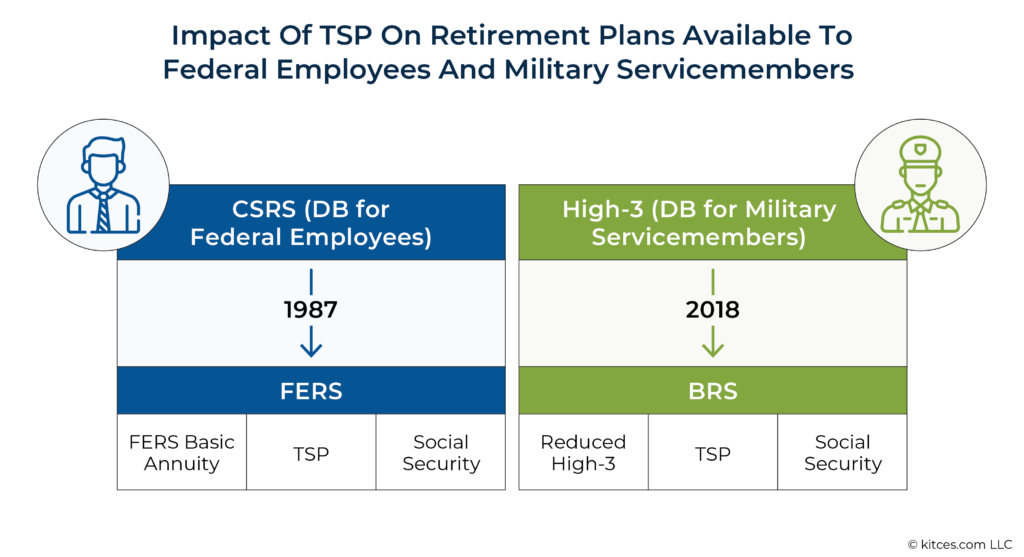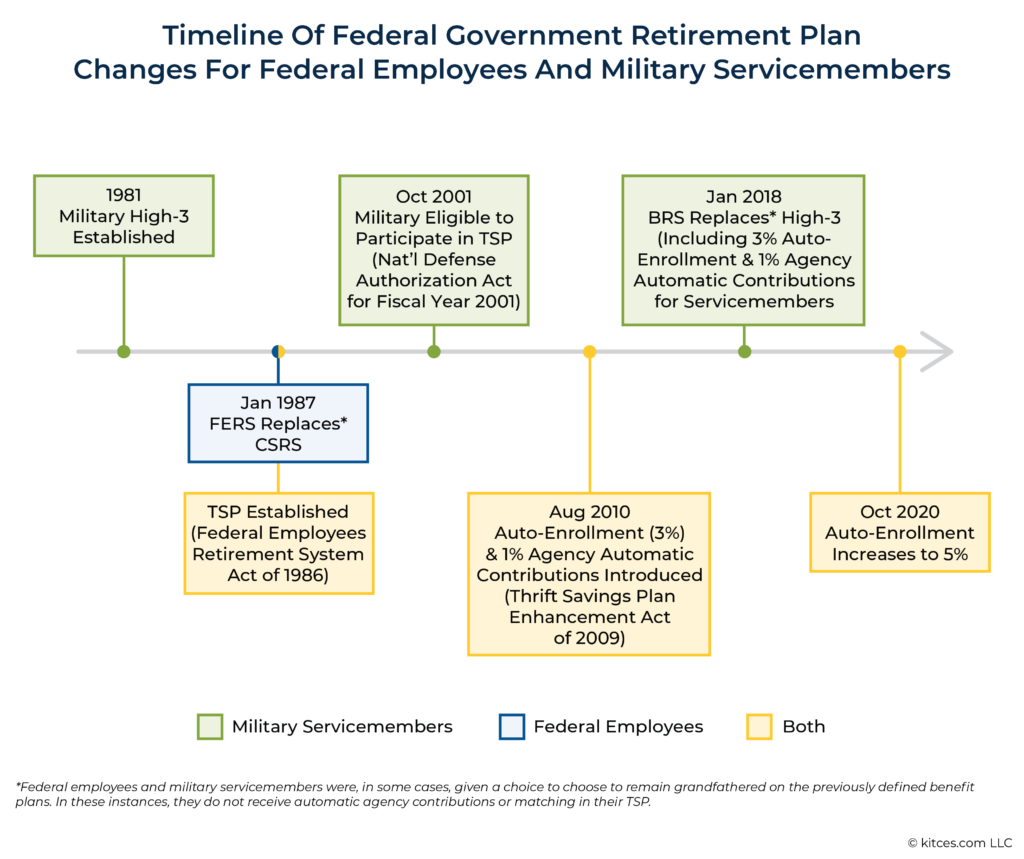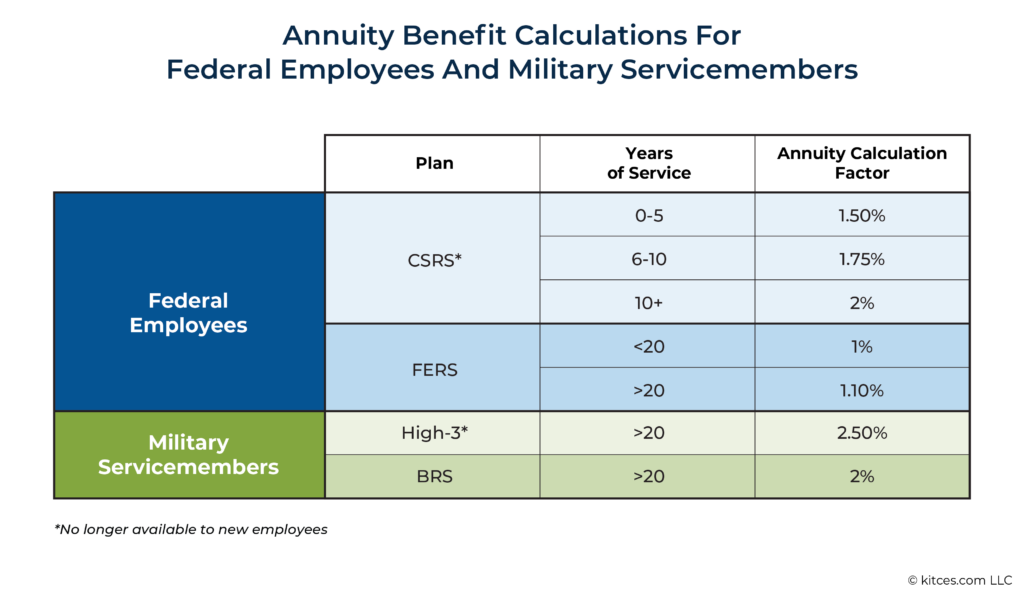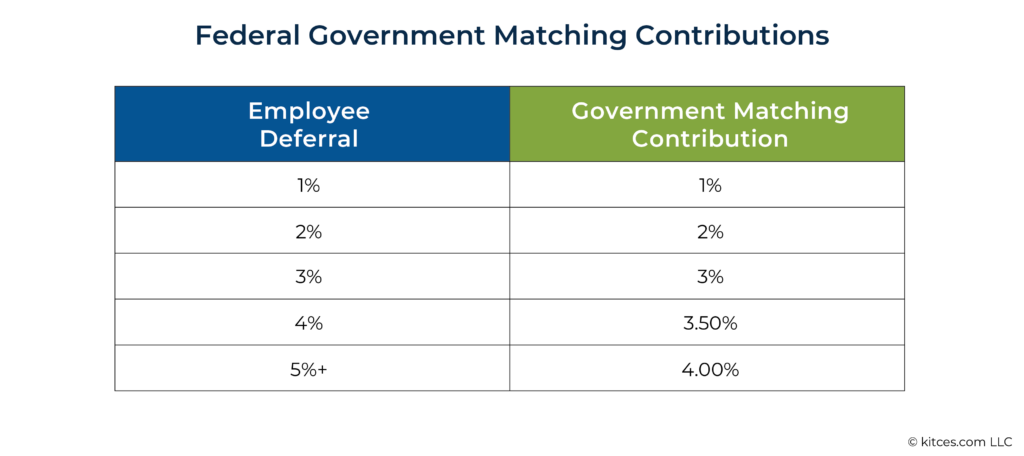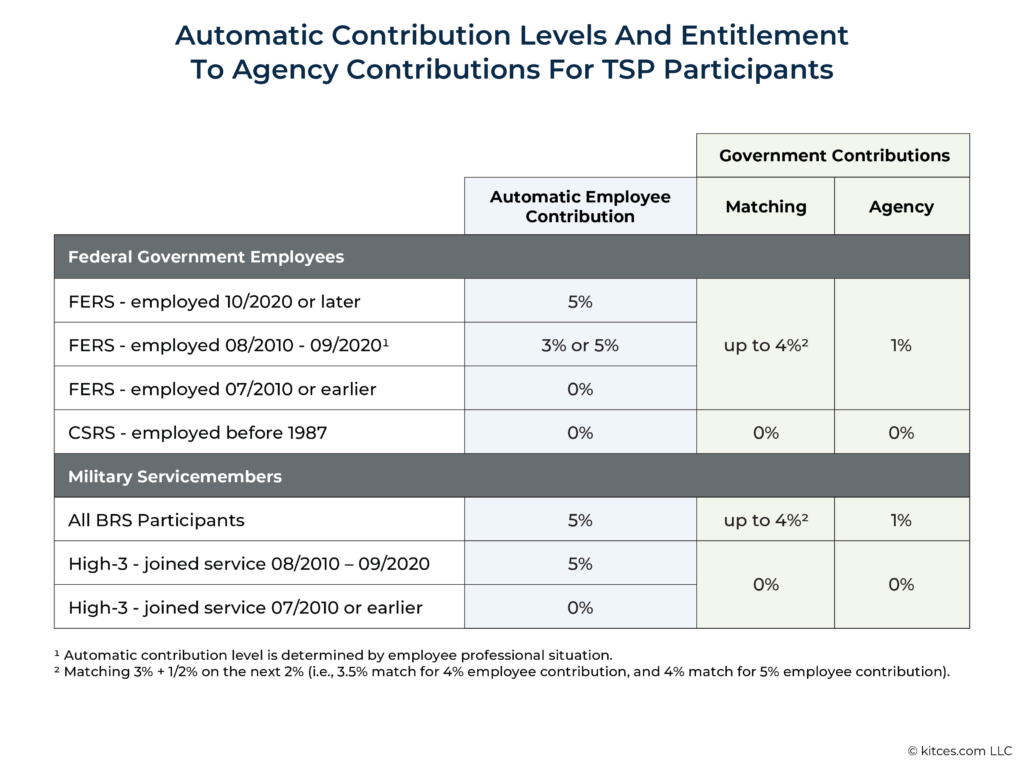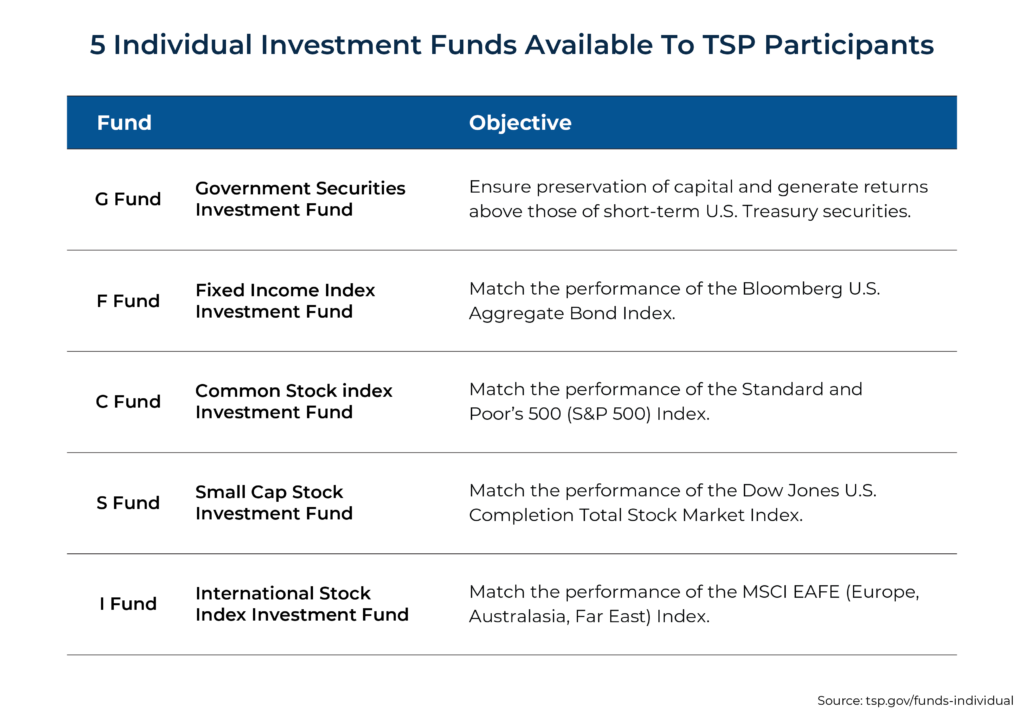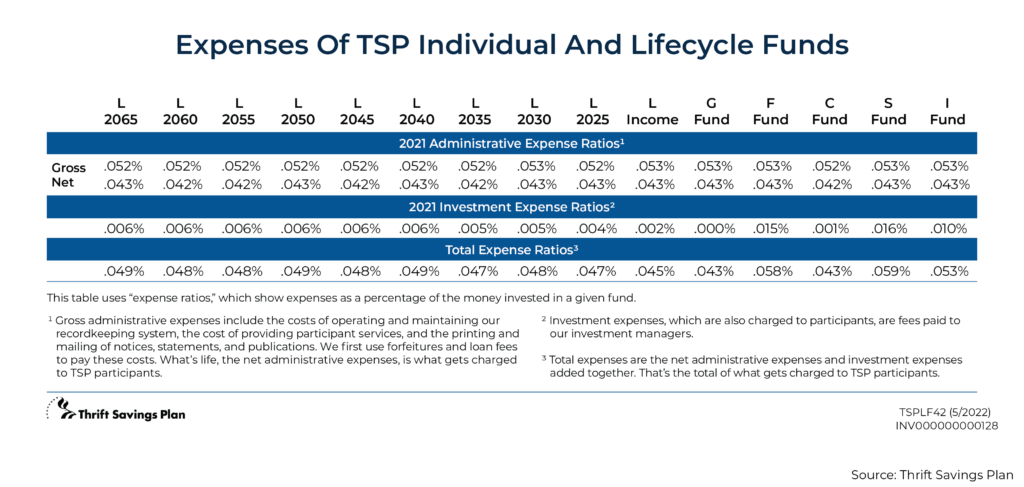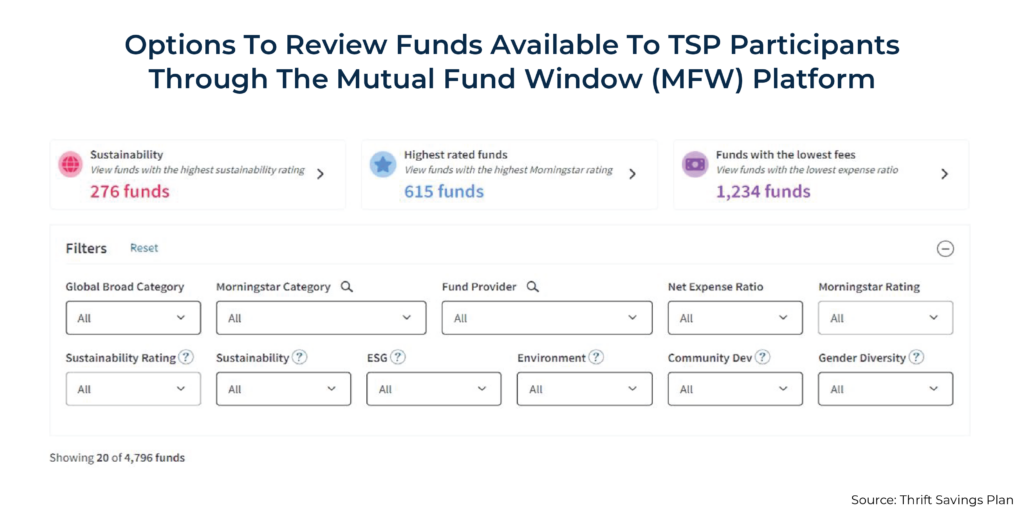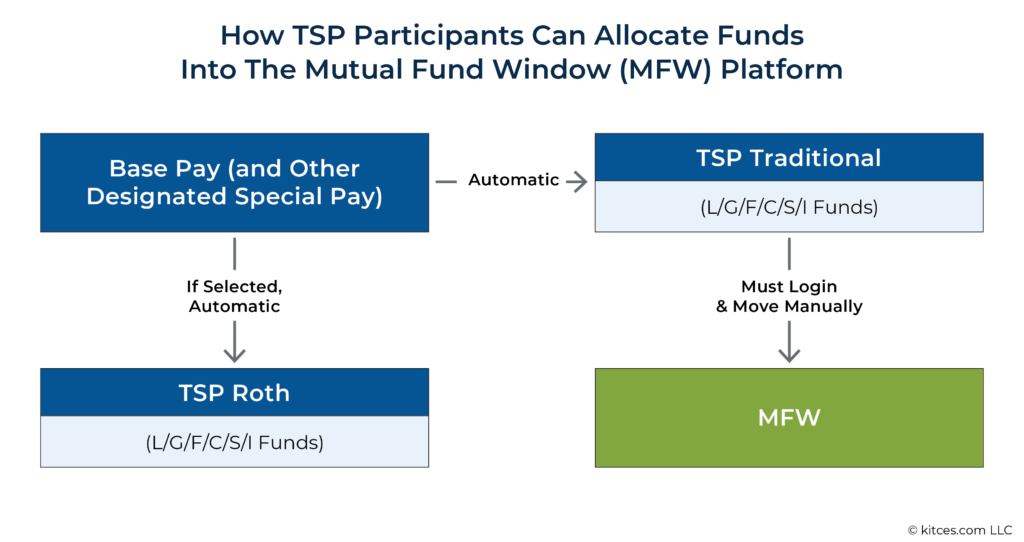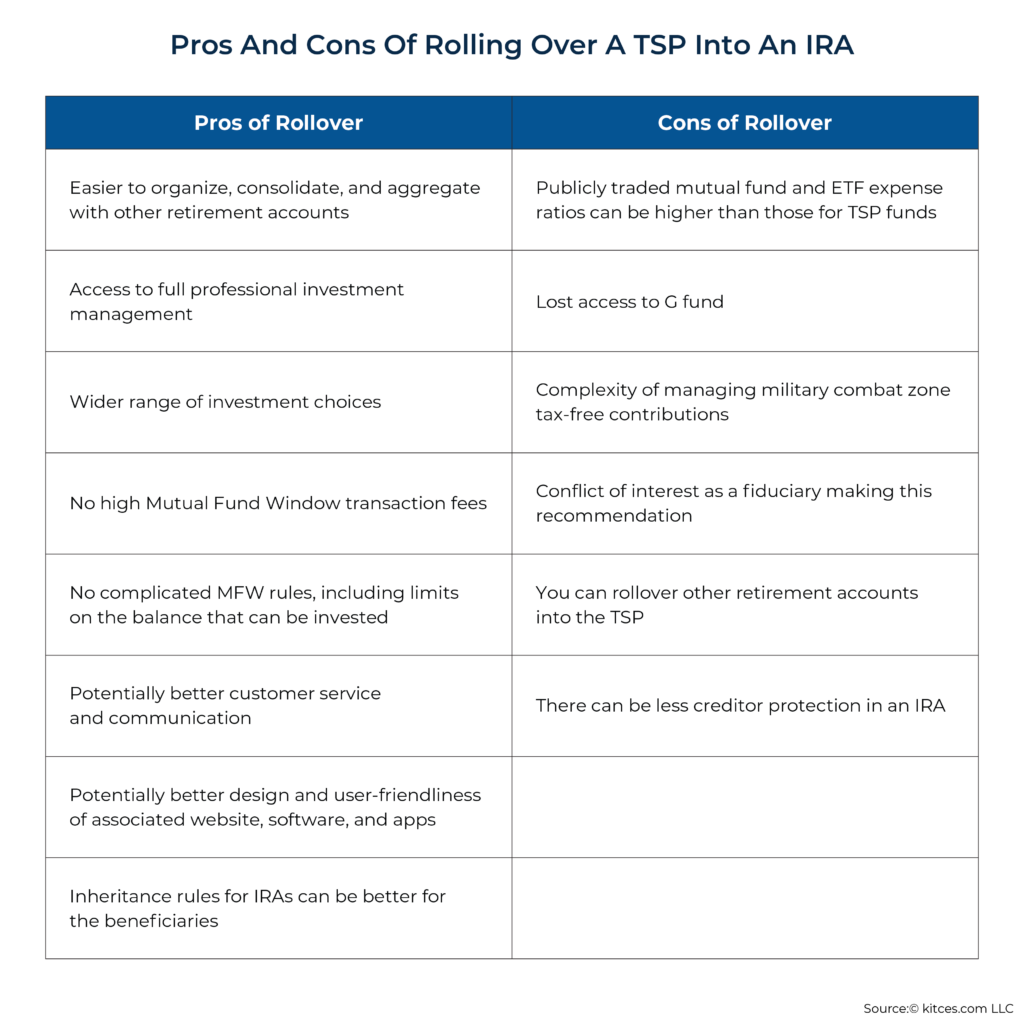Executive Summary
Seasoned financial advisors have likely worked with clients with a wide variety of workplace retirement accounts, which can vary in terms of their investment offerings, fees, and other characteristics. But given that the U.S. government is the largest employer in the country, it can be especially helpful for advisors to be familiar with the ins and outs of (and recent changes to) the Federal government’s own defined contribution plan: the Thrift Savings Plan (TSP).
The TSP is available to both civilian Federal government employees as well as military servicemembers, and those who have left service can choose to maintain their TSP accounts (though they can no longer make contributions). While many features of the TSP (e.g., Roth contribution options and employer matches) are common to other workplace-defined contribution plans, the TSP has certain unique attributes, including lower fees than many private-sector plans and a fixed-income investment option exclusive to the plan.
In 2022, the TSP underwent a series of changes impacting its many account holders. These include the opening of a “Mutual Fund Window” to supplement the limited offering of investment funds previously available to plan participants (though the associated expenses make it prohibitively expensive for many participants). In addition, the TSP updated its website and introduced a smartphone app, which required participants to create new credentials and verify their personal information. Notably, advisors can support clients in navigating these new changes by helping them decide if investing through the Mutual Fund Window makes sense, walking them through the registration process for the new site (if they have not already), and ensuring that their information (including beneficiary information) transferred over correctly.
Advisors can also add value for clients who are TSP participants by understanding how the TSP fits within the Federal employee and military retirement systems, which combine the defined contribution TSP feature with a defined benefit pension (though because the value of this pension has been reduced, TSP management has increased in importance). Further, advisors can support these clients by helping them manage the retirement savings choices that come with career transitions; for example, because many military members have ‘encore’ careers (as they are often eligible to retire well before ‘traditional’ retirement age), balancing their cash flow and retirement savings needs is crucial during their transition period.
Advisors working with clients who have been deployed to combat zones can also add value by being aware of the related TSP considerations. For instance, because income earned while deployed in a combat zone is tax-free, any pre-tax TSP contributions can result in a commingling of tax-free combat pay and taxable earnings (though this can be prevented by making Roth contributions during periods where income is untaxed). In addition, the annual deferral limit increases significantly during the year of a combat deployment, providing an opportunity to contribute even more money to the TSP (if doing so fits within the client’s cash flow plan).
Ultimately, the key point is that while the TSP is similar to many other workplace retirement plans, advisors who understand its unique attributes and stay up to date with its ongoing changes can better serve the Federal employees and military servicemembers who participate in the plan. And given that there are about 6.2 million TSP account holders, these individuals represent a large potential pool of clients!
The Thrift Savings Plan (TSP) is a workplace retirement plan for Federal employees and military servicemembers (including active-duty military, reserves, and National Guard) that is very similar to a 401(k) plan. Veterans and former Federal employees can still hold their TSP accounts, although they can no longer make contributions. In total, the TSP has approximately 6.2 million account holders and over $800 billion in assets, which represents a large pool of potential clients for financial advisors. How the TSP works and recent changes made to the plan are key elements that advisors need to understand to provide financial planning for this large client population.
TSP Background And Information
On January 1, 1987, the Federal government, as the single largest employer in the U.S., established the Thrift Savings Plan (TSP), a defined contribution plan that became a vital component of its retirement plan for Federal employees and military servicemembers. At that time, the defined benefit retirement plan for civilian employees, Civil Service Retirement System (CSRS), was replaced with the Federal Employees Retirement System (FERS). The FERS retirement plan includes a basic annuity, the TSP, and Social Security. These changes were made in part to reduce costs for the Federal government.
To further reduce the financial burden on the government and align with the retirement plan options for civilian employees more closely, the Federal government also transitioned the defined benefit plan for military servicemembers on January 1, 2018, replacing their High-3 defined benefit plan, originally established in 1981, with the Blended Retirement System (BRS), which, like the FERS, also includes a TSP component as well as Social Security.

Nerd Note:
Federal employees and military servicemembers were contributing toward and eligible for Social Security prior to the shift away from the defined benefit plans. It was not an additional benefit introduced with the transition to TSP, but was simply included in the definitions of each plan. Its inclusion was for informational (and maybe marketing?) purposes only, perhaps as reassurance to participants that their Social Security benefits would not be affected by the transition.
When the BRS became available, though, new servicemembers who joined on or after January 1, 2018, were automatically covered under the new BRS plan, while servicemembers with more than 12 years of service as of December 31, 2018, were grandfathered into the old High-3 plan. And those with less than 12 years of service were allowed to choose between finishing out their service on the High-3 plan or switching to the new BRS plan.
In October 2001, military servicemembers were given the option to participate in the TSP through the National Defense Authorization Act. In 2010, automatic enrollment began for new Federal employees and military servicemembers to include a 3% deferral and 1% agency contribution (described in more detail later). The auto-enrollment increased to 5% in 2020, further emphasizing the TSP as an integral part of the FERS and BRS retirement plans.
The shift to the FERS and BRS retirement plans included a reduced defined benefit plan for both long-term Federal employees (the FERS Basic Annuity) and military servicemembers (the Reduced High-3 Plan) along with the defined contribution TSP plan for everyone. A quick illustration of how the 2 defined benefit plans’ annuity benefits are different highlights how the risk and responsibility for the retirement security of our nation’s defenders and the civilian employees of our Federal government have shifted directly onto their own shoulders.
Federal Employee Defined Benefit Annuity Plans:
- The CSRS Basic Annuity is calculated at 1.5% of the highest average basic pay earned during any consecutive 3-year period over the first 5 years of service, plus 1.75% of the highest average basic pay earned during any consecutive 3-year period over the second 5 years of service, plus 2% of the highest average basic pay earned during any consecutive 3-year period over all years of service after year 10.
- The FERS Basic Annuity is calculated at 1%–1.1% of the highest average basic pay earned during any 3 consecutive years of service, depending on the age of the retiree and the number of years of service at the time of retirement.
Military Servicemember Defined Benefit Annuity Plans:
- The legacy High-3 military retirement annuity requires a minimum of 20 years of service and is calculated at 2.5% of the highest average pay earned during any 36-month consecutive earning period.
- The BRS annuity is calculated at 2% of the highest average basic pay earned during the 36 months of basic pay.
There are several special circumstances and provisions that are not covered by this brief summary. However, what is clear is that Federal employees, especially those employed over 10 years, have severely reduced their pension annuity prospects, and military service members have taken a 20% cut.
Enrollment And Contribution Features For Military Servicemembers And Federal Government Employees
In order to encourage retirement savings, automatic salary deferrals are established for all new plan participants. And while the TSP does include a Roth feature, automatic deferrals made by employees (and government matching contributions) are designated to the pre-tax component of their TSP.
The TSP allows for matching up to 4% through both the FERS and BRS plans. While the first 3% of employee contributions are matched dollar for dollar, the next 2% is only matched at 50%. Which means that Federal employees and military servicemembers must defer 5% to capture the full matching potential (which is why automatic employee deferrals are now set at this level).
New Federal employees are automatically enrolled in the TSP (through FERS), and 5% of their base pay is automatically deferred into a target-date ‘Lifecycle Fund’ (described in more detail later), which is selected based on their age. Federal employees who started their employment between August 2010 and September 2020 have either 3% or 5% of their base pay automatically deferred, depending on their professional situation. And Federal employees who were hired before August 2010 have no automatic payroll deferrals contributed to their plan, though they may elect to defer at any time.
All Federal employees under the FERS plan, regardless of when their employment began, receive a 1% agency contribution (these contributions are not deferred income; instead, they are direct contributions made by the agency). The 1% agency contribution is vested upon either 2 or 3 years of service, depending on the employee’s role within the Federal government.
Furthermore, long-standing Federal employees hired before 1987 (when FERS was introduced) who opted to keep their CSRS plan are not automatically included in the TSP automatic deferral. However, they can still contribute to the TSP, but without any agency matching or agency contribution.
New military servicemembers are automatically enrolled in the TSP, and 5% of their base pay is automatically deferred to the Lifecycle Fund that is selected based on their age. All BRS plan participants are automatically enrolled at 5%, regardless of when they entered service. The High-3 plan participants that joined the military between August 1, 2010, and September 30, 2020, are also automatically enrolled at 5%. Servicemembers who joined before August 2010 and who did not elect the BRS (i.e., they chose to stay on the High-3 plan) are not automatically contributing to the TSP at all. Like Federal employees in the FERS program, they can still opt to contribute to the TSP, but they would have to actively make that deferral election with their agency.




Nerd Note:
Military base pay is the salary based on rank and excludes housing, clothing, cost of living, bonuses, and special pay (for example, combat pay). These additional categories of non-base pay may be contributed into the TSP upon request of the participant.
Any servicemembers who were automatically enrolled in BRS (i.e., those who joined on or after January 1, 2018) and those who elected to switch to BRS from a different plan (i.e., those who joined before BRS was established and switched from their original plan) also automatically receive a 1% agency contribution in their TSP. The 1% agency contribution is vested upon 2 years of service. Those who chose to maintain their High-3 plans do not get the 1% agency contribution.
Notably, TSP participants, which may include CSRS and High-3 plan employees who choose to defer, as well as FERS and BRS participants that receive automatic deferrals, can change their contribution at any time. They can increase or reduce their contribution and even drop their contribution to zero.
TSP Investment Options
Prior to the plan changes implemented in June 2022, participants were only offered a selection of 5 individual funds, consisting of a Government Securities fund (G Fund), Fixed Income Index fund (F Fund), Common Stock Index fund (C Fund), Small Cap Stock Index fund (S Fund), and International Stock Index fund (I Fund). Participants can still invest their assets into these individual funds in any combination that they choose.
The G Fund is particularly worth mentioning as it is a fund unique to the TSP. It is invested in short-term U.S. Treasuries exclusively issued to the TSP, and the payment of interest and principal is guaranteed by the U.S. Government. The very limited risk that comes with these special assets allows for a long-term type of yield (not accounting for an inverted yield curve). With our current economy, including high inflation, high interest rates, and high volatility, many current TSP participants have recently flocked to this fund.
Another fund worth mentioning is the TSP’s Small Cap Stock Index Investment Fund (S Fund). It is based on the Dow Jones U.S. Completion Total Stock Market Index, which is “a subindex of the Dow Jones U.S. Total Stock Market Index that excludes components of the S&P 500” and, in addition to small-cap stocks, includes several large- and mid-cap stocks (for example, its 4 top holdings currently include large-cap companies Uber, Blackstone, Pal Alto Networks, and Lululemon Athletica). So to title this fund a “Small Cap Stock Index Investment Fund” may be misleading to the participant.
In addition to these 5 funds, participants can also choose from 10 target-date funds called Lifecycle Funds (L Funds), which consist of varying combinations of the 5 individual funds and are rebalanced on a quarterly basis to adjust for the participant’s risk level (based on the expected year of retirement).
According to the TSP website, L Funds were “designed to let you invest your entire portfolio in a single L Fund and get the best-expected return for the amount of expected risk that is appropriate for you.”




Nerd Note:
Within a 5-year window of when the TSP predicts the participant will begin withdrawing funds, the participant’s particular target-date Lifecycle Fund phases out and becomes the “L Income Fund”. Like target-date funds in general, this is a very large window and a very large assumption made on behalf of the participant. The return on investment since inception for the L Income Fund is 3.91%.
The expenses for the Individual Funds and target-date Lifecycle funds are relatively low and on par with the lowest-cost funds available from major fund providers (and significantly lower than many of the funds offered in other workplace retirement plans), with total expense ratios ranging from 0.043% (for the Government Securities Investment G Fund) to 0.059% (for the Small Cap Stock Index Investment S Fund).
In June 2022, a new TSP Mutual Fund Window (MFW) was introduced to supplement the limited offering of individual and L funds. The MFW offers almost 5,000 new funds, including funds from iShares, Vanguard, State Street, Blackrock, Fidelity, and many others.
Participants can research the available options by filtering for ratings, fees, sustainability, provider, category, and more. It is administered by the Federal Retirement Thrift Investment Board (FRTIB), which has contracted with Alight Financial Solutions LLC as broker and Pershing LLC as custodian. The MFW has a separate application and login process from the TSP platform, as its operations are all managed through these third parties.
In order to invest funds through the MFW, participants must meet relatively high minimum requirements and pay exorbitant fees. In particular, they must have a minimum of $40,000 in overall value in the TSP, with a minimum initial contribution of $10,000 (though contributions made into the MFW are limited to a maximum of 25% of the participant’s overall TSP account value at any given time). If the value invested through the MFW exceeds the 25% limit (e.g., on account of growth in the funds), no action is required, but further contributions will not be allowed until such time that any new contribution would result in the MFW account balance being at or below 25% of the total TSP account value. Furthermore, participants must pay an annual fee of $150 (including a $95 maintenance fee and a $55 administrative fee) and trading fees of $28.75 per trade (!!!).
Problematic TSP Updates
As vital as the Thrift Savings Plan (TSP) is to the retirement of both our nation’s defenders and the civilians working for our nation’s largest employer, having a robust platform and service provider is imperative. With much anticipation, the TSP implemented several major changes in the Spring of 2022 to this end. The primary intent of the recent changes was to modernize the system, enabling participants to access their account information through a new user-friendly website, offering a new smartphone app, and adding investment choices to the very limited fund choices previously available. Unfortunately, the upgrade has not gone quite as well as planned.
Since its release, many have been very critical of both the new site and the new investment options. The Government Accountability Office (GAO) has even agreed to investigate the poorly executed transition of the TSP program to its new platform, following the request of several members of Congress due to their constituents’ complaints.
Accessing the new site requires participants to provide all new credentials (username, password, PIN) and to verify their identity, contact information, and other account details. As with most processes that involve logging into online systems that give access to private financial information, this is time consuming, complicated, and frustrating. And upon setting up their new credentials, many participants have been faced with numerous error messages upon logging in and trying to access past account statements (as of February 2023, statements from before the June 2022 system update are not available online; they must be requested directly from TSP).
Why Professional Advice Is Critical For TSP Participants
As with many busy professionals who invest much of their lives into their careers, military servicemembers and Federal employees are focused on their very important missions and not often focused on the important nuances of their retirement plans. While a high-level overview of a participant’s retirement plan is sometimes available within their respective agencies, professional advice is available to neither Federal employees nor military servicemembers.
The TSP website has an online learning center with webinars and calculators for general information. And although they also have representatives for general questions and a live chat option as a part of the new website, there are many participants with unique circumstances that often warrant specific financial advice that can be hard to find without professional assistance.
For example, for participants deployed in a combat zone (which must be declared as such by Executive Order), any income earned is tax-free, and any of that tax-free income used to fund a traditional TSP during that period will also be tax-free. However, it is important to note that the earnings on that tax-free contribution will be taxable (unless they were contributed into a Roth TSP). Which means that the account will now include a commingling of tax-free combat pay, taxable earnings on those (tax-free) combat-pay contributions, and taxable contributions from non-combat income. When it is time to withdraw these commingled funds, it can be very complicated; mistakes can often be made to the disadvantage of the participant, even though the TSP keeps records of all tax-free contributions.
Additionally, while the annual deferral limits for the TSP are $22,500 in 2023 (plus a $7,500 catch-up contribution for participants age 50 and older), the limit increases to $66,000 (for 2023) during the year of a combat deployment. This includes both the participant’s contributions and the agency’s contributions combined (excluding catch-up contributions). Therefore, not only is there a tax benefit, but there is also an increase in the amount the participant may contribute tax-free.
Financial advice for retiring or separating military servicemembers is extremely important because the transition from military to civilian life can be complicated, expensive, and stressful. Servicemembers in the Army, Navy, Air Force, Marines, Coast Guard, Space Force, Reserves, and National Guard have been participating in the TSP during times of war for most of their service.
Their transition to civilian life – whether it is after a few years of service or retiring after decades – is filled with unique challenges. The military’s Transition Assistance Program (TAP) does educate transitioning servicemembers about money matters. However, this is a basic, one-size-fits-all program that may not address the unique needs of individual servicemembers. Cash flow, insurance, taxes, and of course, investments, are the priorities, and a misstep at this critical time of transition can have enormous long-term financial consequences.
Cash Flow Planning Challenges For Servicemembers Transitioning Back To Civilian Life
One of the most frequent missteps that occurs with servicemembers transitioning back to civilian life is in regard to cash flow. 4 major vulnerabilities surround the time a servicemember leaves service, and any one of these potential situations may send the individual to their TSP looking to withdraw money when they do not understand the consequences of doing so:
- The final paycheck does not always arrive on the date expected because it is audited for accuracy. It can be delayed for days, weeks, or even months.
- An 'encore' career often follows military retirement, especially when the servicemember is still relatively young. The next paycheck may take some time because it can be challenging for them to effectively communicate their military experience in terms of skills that the civilian workforce will value and understand.
- There may be many new expenses, which can include new housing and civilian clothing.
- Retirees who receive a taxable pension may not understand that an encore career may increase their tax bracket and that their withholding should be adjusted accordingly.
Especially with military clients, and possibly counter to many civilian client relationships, the spouse may be the person responsible for managing certain aspects of the finances since deployments and time away from home shift that delegation of duty. This makes it important to identify the financial manager in the discussions at all levels of the planning process.
Servicemembers likely have not focused their time or attention on developing expertise in financial matters. In some cases, the servicemember may have delegated only day-to-day responsibilities to that spouse or another family member. In other cases, they may have delegated long-term financial responsibilities like managing the servicemember's participation in the TSP.
When it comes to Federal employees, the breadth of service they provide is diverse, with roles in law and legislation, intelligence, science, finance, executive administration, and more. And because these careers also come with their own set of unique challenges and requirements, Federal employees can also benefit from the support of financial advisors just as much as, if not more than, military service members.
Actionable Steps For Advisors Supporting TSP Participants
There are many opportunities for financial planners to provide advice for Federal employees, military servicemembers, veterans, and their families. While these prospective clients may not typically fall into an advisor’s AUM minimum requirements, increasing the diversity of industry fee structures (e.g., subscription, hourly, flat fee) can allow for the possibility of helping them by providing advice on their held-away TSP assets or on assets rolled from the TSP into a managed account, since TSP assets can be rolled out of the TSP once the employee has left service, like other workplace retirement plans.
Helping Participants Understand How The TSP Works
Goal setting, financial planning, and retirement planning are some of the first steps that financial advisors can help TSP participants navigate. Many Federal employees and military servicemembers may automatically be investing 5% of their income without ever having logged into the TSP site to see how their contributions are invested. They may be surprised to find out that their Lifecycle Fund (assigned by default) does not match their risk preference and that their 5% contribution, even with matching, will probably not be enough to deliver them to their retirement goals. And while the TSP defaults to a traditional tax-deferred account, many participants don’t realize that there is a Roth option. Participants can designate contributions to either account by making changes to the withholding elections administered by their agency.
Next, advisors can walk clients through the process of logging into the new system, which is even more complicated than it was before the transition. This value-added level of comfort in a potentially confusing and uncomfortable situation can be a great opportunity for the advisor to establish a lasting relationship by helping the client explore the site and download the new smartphone app. Aggregating the TSP (and now the MFW) through advisor aggregation software programs has been challenging in the past but is another option.
Verifying TSP Beneficiary Designations
Advisors can also help clients confirm that their TSP account beneficiaries are set up correctly and according to their wishes. This is especially important for those who were enrolled during the 2022 TSP update, as beneficiary data failed to transfer to the new system for some participants.
My husband has a TSP through his current Federal employment and discovered that his listed beneficiaries were lost during the TSP transition. Fixing the omission proved to be a very frustrating and complicated process. He also inquired with his staff and within our veteran-connected community to see if others had similar issues with their accounts. Many had no beneficiaries listed where they were listed previously, confirming the extent of this problem went beyond just a few cases.
The Federal Retirement Thrift Investment Board has since acknowledged that some beneficiary designations were not transferred to the new system but that the information was maintained offline. Verifying that beneficiaries are correct in each account is crucial.
Reviewing Asset Allocation And Investment Strategies
Another opportunity for advisors to help TSP participants is to help them assess their current asset mix and to assess whether their contributions are being invested to align with their needs and risk tolerance. This can be done while the participant is logged into their account and can serve as a great occasion to discuss rebalancing and meeting retirement income needs.
It is important to note that all future TSP contributions, regardless of whether any Mutual Fund Window (MFW) funds have been chosen in the past, are put in the L/G/F/C/S/I Funds until the participant manually moves them into the MFW. There is no ‘set-it-and-forget-it’ feature where contributions can automatically be allocated into MFW funds; it is very hands-on and arduous.
As mentioned earlier, the fees for the MFW, in comparison with other TSP investment options, are excessive. For example, considering the TSP C Fund expense ratio of 0.043% and the $150 in annual fees for the MFW (before even including the individual transaction fees and fund expense ratios), the participant would have to invest at least $150 ÷ 0.043% = $348,837 just to breakeven.
And because participants can only invest up to 25% of their TSP overall value, this means their overall account value would have to be at least $348,837 (MFW breakeven level) ÷ 25% = $1,395,349 … nearly $1.4M!
As of August 2022, there were only about 72,000 TSP millionaires: about 1.7% of all accounts. So, the MFW is not cost-effective for most participants when compared to the funds already available in the TSP. The advantage of the MFW must come through a steep return on investment.
Coordinating TSP And Defined Benefit Investments
As noted earlier, all Federal employees and military servicemembers have the opportunity for a defined benefit plan through continued service. Understanding each of these plans and how the TSP can complement them is another important planning contribution advisors can offer.
Furthermore, long-time Federal employees and servicemembers with grandfathered CSRS and High-3 defined benefit plans, respectively, are also able to contribute to the TSP. While these defined benefit participants who choose to contribute to the TSP do not have employer-matching benefits, they can still supplement their future retirement annuity with this investment opportunity as well.
Choosing When To Rollover TSP Accounts To Roth/Traditional IRAs
Finally, perhaps the greatest opportunity for advisors to support TSP participants is to help them decide whether to roll their TSP account over to an IRA (Traditional and/or Roth) after the participant has left their agency. There are many factors to discuss beyond simply expanding investment opportunities. Other important considerations include rolling other retirement plan assets into the TSP (yes, this can be done!), inheritance rules (this may not be fun to think about, but it’s important to make things as seamless as possible for beneficiaries), understanding the potential conflicts of interest advisors can have as fiduciaries making these recommendations, and the often overlooked effects on asset protection from creditors.
For example, my husband, in addition to having an active TSP through his current Federal service, had a different TSP account through his previous military service. He had made contributions with both tax-free combat income and taxable non-combat income, which meant that both tax-free and taxable funds were commingled in his TSP account (we did not understand at the time that contributing these tax-free funds directly into a Roth TSP would have eliminated this complication). He could not roll the tax-free portion of his TSP into a Roth because while the contributed income was tax-free, the earnings were not.
So, his options were to leave everything in the TSP, leave only those tax-free funds in the TSP (and thereby separate them from the taxable portion that could be rolled into a Traditional IRA), or move everything and keep excellent records for the custodian and the IRS. He chose to move the whole account into a Traditional IRA. He was willing to take the risk of future confusion and challenges dealing with those commingled tax-free funds so that I would be able to manage the portfolio. Every TSP participant will have to weigh their own pros and cons. Not all TSP participants have tax-free income in their accounts, but after decades of war, many do, so advisors should be sure to ask them.
TSP participants may not fit the standard demographic serviced through traditional AUM models. It is clear, however, that both the largest employer in the U.S. and the uniformed services have ample prospects that need advice and support. Setting up this vulnerable population for future financial success is more than our patriotic service. It is our fiduciary duty.
Furthermore, while the Thrift Savings Plan is a satisfactory workplace retirement plan, when it tried to take steps forward to improve and update its system, it unfortunately ended up taking a few steps back. Before the update, there were many opportunities for financial planners to provide advice; now, after the TSP’s attempt to update their system, the opportunities for advisors to help have increased tremendously.
For advisors who feel called to take even more action, there are also pro bono opportunities through the FPA Homes for Our Troops program and the NAPFA Building Homes for Heroes program serving some of our most vulnerable veterans.


